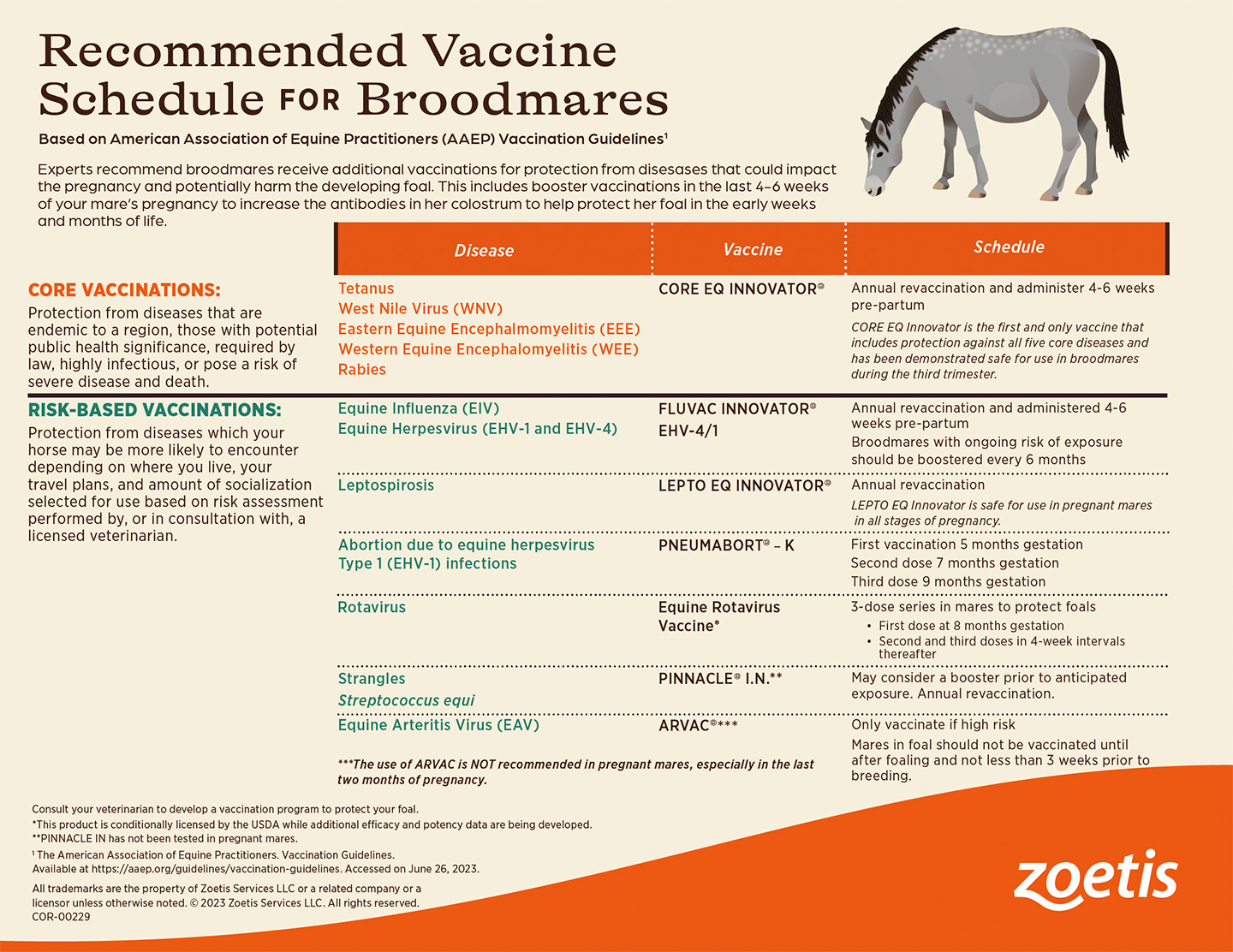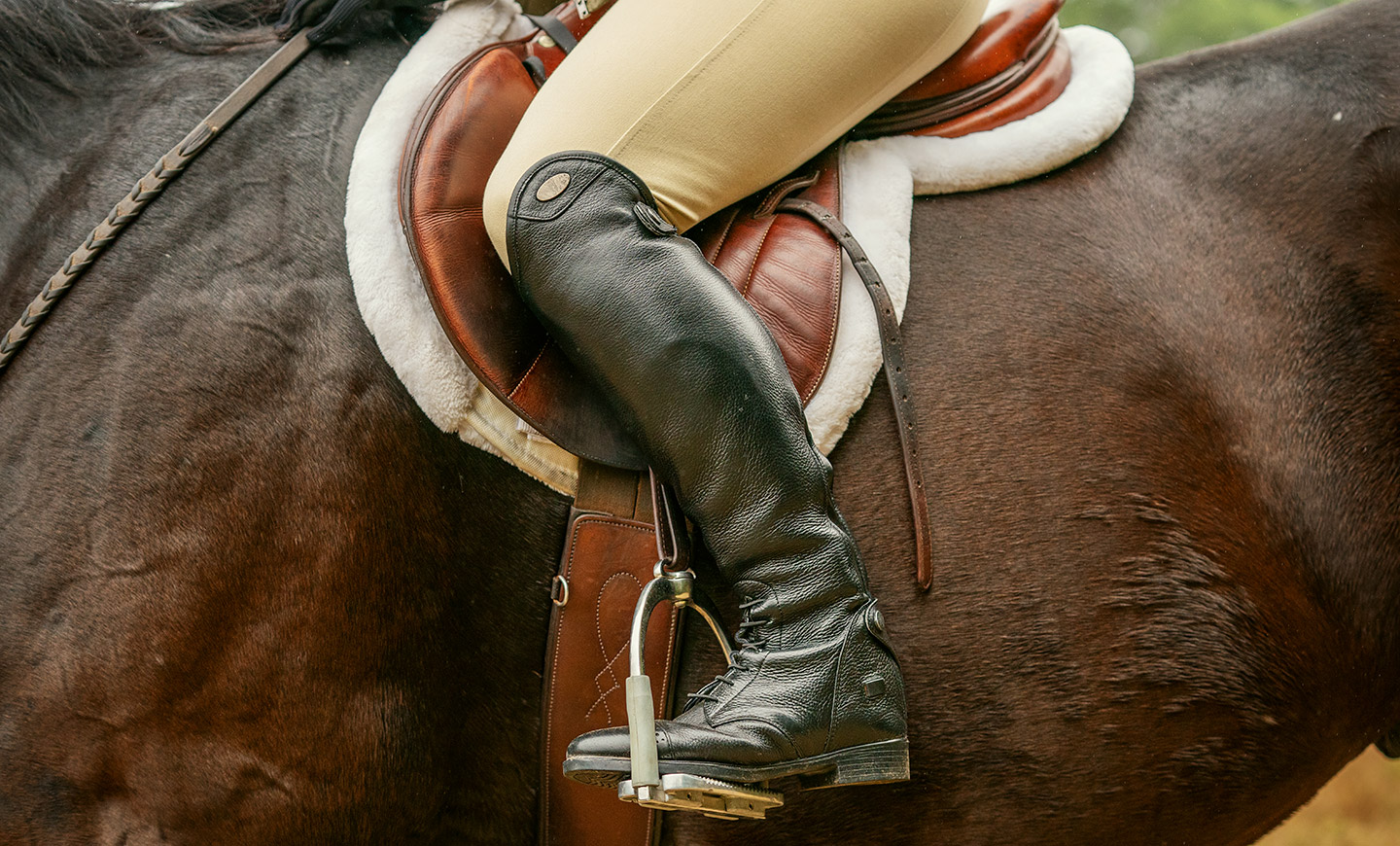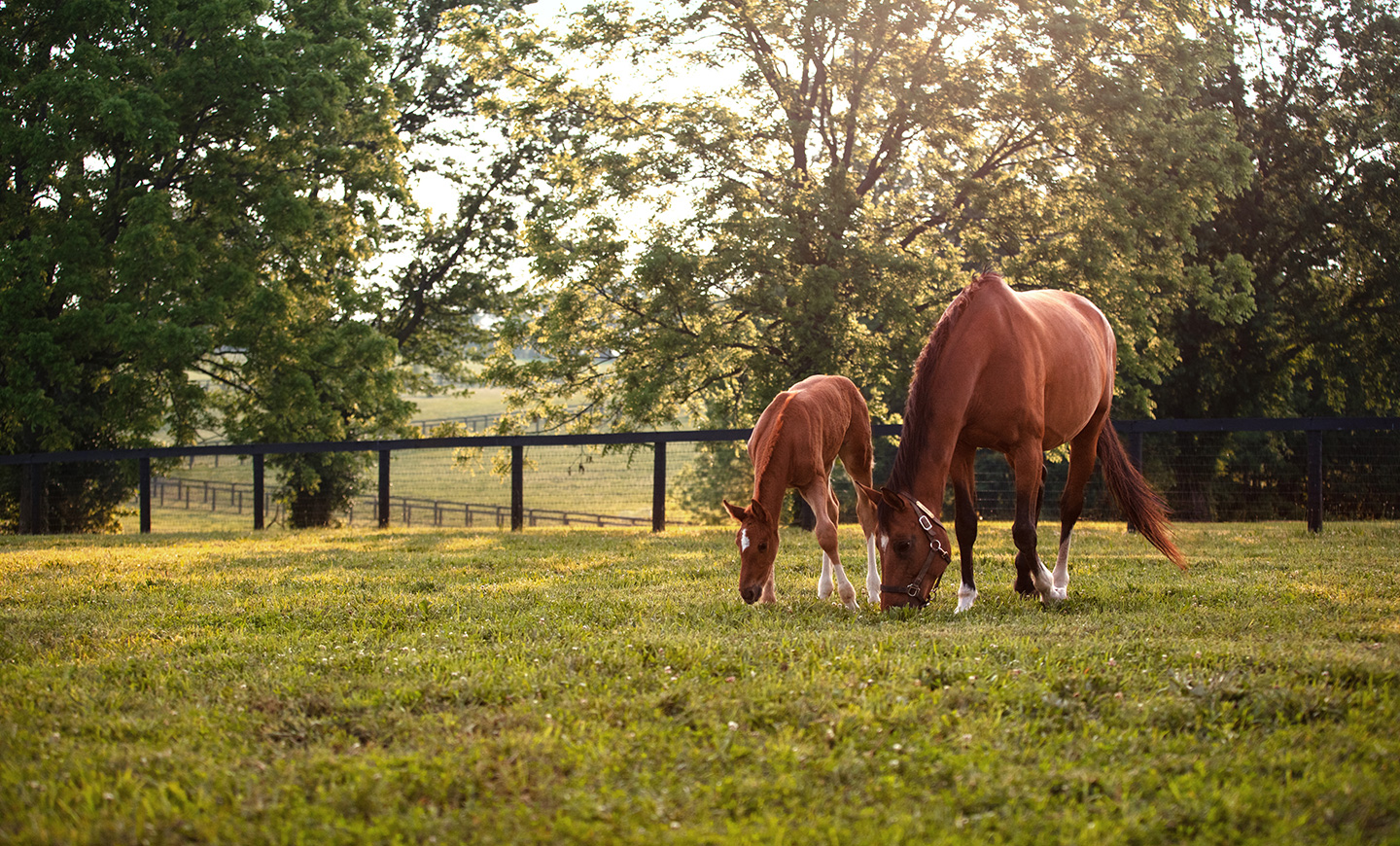Biosecurity Tune-Up: Broodmare Care Edition
Abby Sage, VMD, MS, DACVIM, Equine Technical Services Veterinarian, Zoetis
8/22/2024



From equine herpesvirus and the flu to leptospirosis and rotavirus, a number of threats are dangerous to any horse but are particularly important to guard against in broodmares. Without the right protection, these and other common equine diseases can have a significant impact on pregnancy, even leading to abortion.
Fortunately, there’s a lot we can do to ensure the safety of both the mare and foal. Throughout my years as a veterinarian, I’ve become more and more interested in the art and science of designing and fine-tuning broodmare biosecurity programs, and I’m excited to share some of my accumulated wisdom here.
The following roadmap can help you build a plan from the ground up or bolster a current one to instill greater confidence.
Here are the biosecurity topics we’ll cover:
1. Broodmare travel: quarantine, disinfection and diagnostics
2. What to do if a broodmare or another horse in the herd is sick
3. How to focus on prevention
4. A case for diagnostic testing throughout each trimester
5. Boosting antibodies in the third trimester to support colostrum
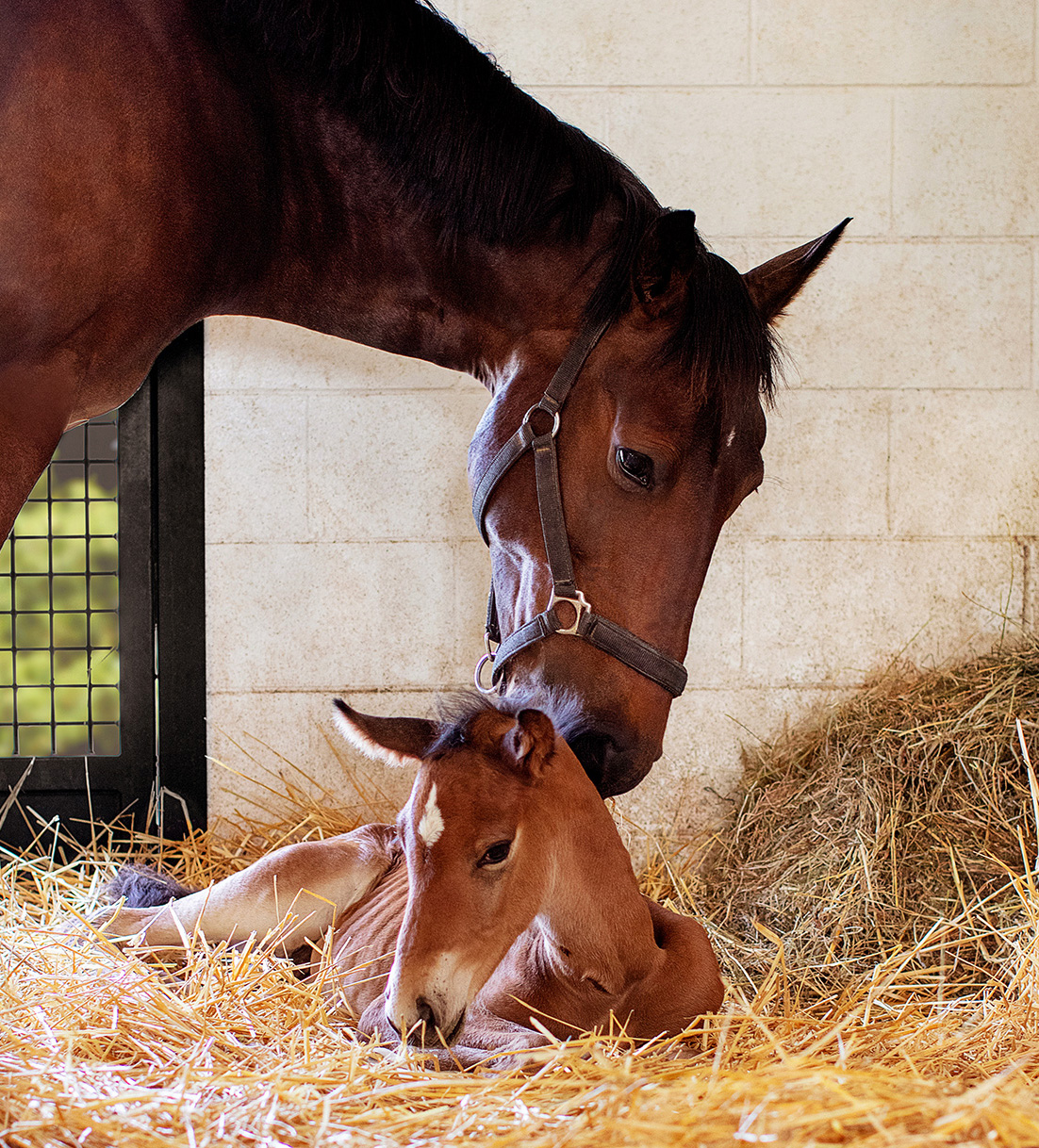
As a board-certified large-animal internist and private practitioner, some of my favorite days include attending to pregnant mares, checking in and making sure everything is progressing to plan. Then there are those quiet moments that take you aback in the sweetest of ways: noticing a newborn nestling up in the fresh straw for a power nap or frolicking out in the pasture while starting to explore his surroundings.
I’ll be honest: I’d rather share those moments with you than come into the middle of a potentially infectious disease outbreak. Since we’re discussing proactive biosecurity, it’s important to recognize the gravity of why we take such careful measures to ensure the health and well-being of our mares and the foals we anxiously await each year.
One example that hits home for me is what I experienced on a recent farm visit. It took just one horse on the farm to be exposed to equine herpesvirus type 1 (EHV-1) for it to spread to five pregnant mares. That was tough to manage, from logistics to communication to mitigating the spread to other horses on the farm. The broodmares thankfully recovered in the long run, but the staff and attending veterinary crew experienced the anxiety that comes with a potential abortion or how the disease could affect foal growth down the road. What’s tricky about prevention planning is that it sometimes takes a 'caught off-guard' moment for a farm to fine-tune (or even create) a biosecurity program.
Sometimes circumstances like this can be the greatest catalyst for change. My sincere goal is to help you determine the right protocol so that you do not need to experience a situation like the one above while also having a contingency plan just in case. Essentially, let’s do everything we can to avoid an outbreak together. The following reflections and guidance are designed to do just that.
Broodmare travel: quarantine, disinfection and diagnostics
I highly recommend a standard 21-day quarantine to keep pregnant mares that are returning to the farm from the breeding shed separate from the herd as they embark on their first trimester. Here’s what a standard quarantine could look like, along with simple yet crucial biosecurity steps to take:
- Create separate housing and turnout areas: Identify pastures and stalls for returning broodmares that are, if possible, at least 30 feet from other horses, especially those in other life stages, like yearlings, show horses, etc. Although it may seem like a long time, we truly need a 21-day quarantine to ensure broodmares don’t develop a disease before they share the same space with the rest of the herd.
- Disinfection practices: We want to ensure these mares are set up with a freshly cleaned and disinfected stall and buckets. Avoid sharing equipment (brushes, buckets, rags, sponges) or thoroughly disinfect equipment between horses. Remember to also wash your hands as you move from horse to horse as you work through the barn.
- Temperature checks throughout quarantine: I advise temperature checks upon arrival and once or twice a day every day of quarantine before allowing mares to turn out with the rest of the herd. If the thermometer reads above 101.5 F, call your veterinarian and begin discussing next steps if a mare or horse at the farm is sick.
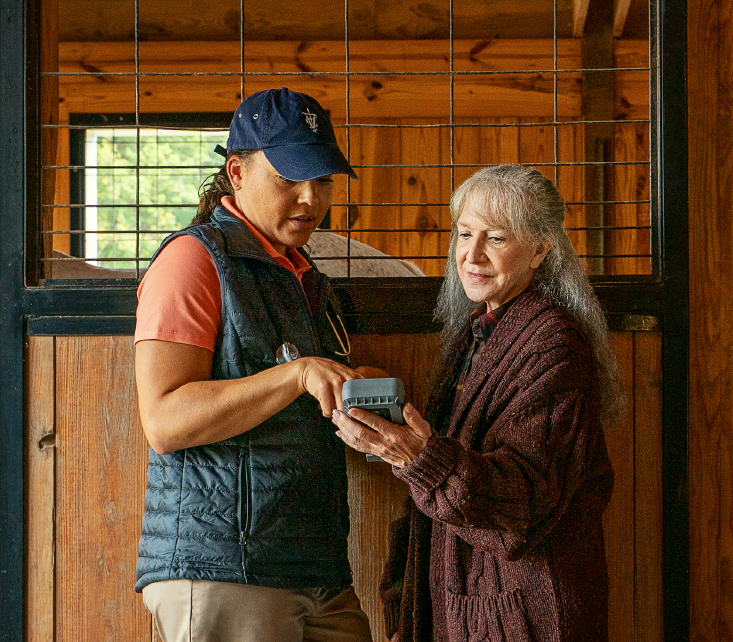
- Serum Amyloid A (SAA) testing for possible infection: I also recommend asking your veterinarian if they have an SAA diagnostic tool like the Stablelab® EQ-1 Handheld Reader. It’s a stall-side device that measures the concentration of SAA in 10 minutes, an early real-time indicator of inflammation caused by infection. SAA has been found to be 30 times more sensitive than a thermometer at detecting subclinical infection, even before horses show signs of being sick.1 Imagine what it feels like to catch a problem before it becomes one!
SAA is a protein the liver produces in response to infection that can indicate if a horse has an infection. Situations when a veterinarian may use Stablelab include:
- Screening horses before, during and after travel
- Checking horses with fevers of unknown origin or in cases of a medical emergency like a potential outbreak to determine which horses to quarantine
- Evaluating a horse’s response to treatment
- At wellness visits (newborn foal and broodmare care exams)
Check out this video Q&A to learn more about Stablelab
What to do if a broodmare or another horse in the herd is sick
For veterinarians, managing outbreaks requires focus, getting everyone at the farm involved in day-to-day horse care and having the right tools to help read the signs, evaluate our mental decision tree and take action quickly. Here are ways that you can support your veterinary team in the face of an outbreak:
1. Have a written plan in place that covers:
- The veterinarian’s contact information
- The location of quarantine stalls
- The location of cleaning agents, personal protective equipment (like disposable booties and gloves), thermometers, etc.
- The personnel in charge of handling affected horses to minimize inadvertent contamination between sick and healthy horses
2. Quarantine any horses with elevated temperatures and/or SAA readings for a minimum of 21 days.
3. Check the temperature and/or SAA levels of quarantined horses and monitor exposed horses for signs of infection, which could include:
- Nasal discharge
- Coughing
- Diarrhea/colic
- Loss of appetite
- Dehydration
- Abnormal urination
- Skin coat changes
- Dull eyes
- Increased heart rate
- Swelling/lumps
- Changes in behavior
- Abortion
4. Continue to disinfect all equipment and ensure quarantined horses aren’t sharing feed or water (or, honestly, anything!) and are 30 feet from healthy horses.
5. Keep your veterinarian informed of any significant shifts you notice in quarantined horses while they’re undergoing treatment under the guidance of your care team.
How to focus on prevention
Although vaccinating doesn’t guarantee the prevention of disease, science has shown that it significantly reduces the risk of clinical signs as well as the duration of disease. Zoetis offers a range of vaccines that protect against some of the more threatening diseases in broodmares, including:
- Core EQ Innovator®: A single shot that protects against all five core diseases, which can be fatal to horses (tetanus, West Nile virus, Eastern equine encephalomyelitis, Western equine encephalomyelitis and rabies)
- Fluvac Innovator® EHV-4/1: Aids in the prevention of equine herpesvirus (rhino) rhinopneumonitis types 1 and 4, which can cause respiratory disease as well as abortion, along with equine influenza (flu) type A2
- Lepto EQ Innovator®: Leptospira is an organism that can cause late-term abortion in pregnant mares
- Equine Rotavirus Vaccine*: Provides passive transfer of antibodies to foals to help protect against rotaviral diarrhea in newborn foals
- Pneumabort-K® + 1b: Effective against abortion due to equine herpesvirus type 1 (EHV-1) and respiratory disease caused by EHV-1p in horses 9 months or older
Our veterinary team at Zoetis has outlined care guidance by trimester on ZoetisMareAndFoal.com, and we’ve included a snapshot below. This broodmare vaccination schedule aligns with recommendations from the American Association of Equine Practitioners (AAEP) is also a great place to start when discussing plans with your veterinarian.
And don’t forget to vaccinate all horses that come into contact with broodmares to provide the most protection! It’s not enough to vaccinate just the broodmares alone.
A case for diagnostic testing throughout each trimester
If a broodmare develops an infection of the placenta (placentitis), she may start lactating early and lose colostrum, leading to the failure of passive transfer of antibodies to the foal. The foal is then susceptible to picking up an infection from his surroundings and other horses. If there’s any challenge to foaling that results in a lack of oxygen to the foal, he has an increased chance of being a “dummy foal,” susceptible to systemic infection. These foals cannot rise or nurse and can spiral downhill within a matter of hours without early and aggressive medical care. To do our best to avoid this outcome, I highly recommend that veterinarians utilize SAA testing throughout pregnancy to screen mares for infection as well as test foals for IgG and SAA as part of any newborn foal examination 12 to 24 hours post-foaling.
If your veterinarian catches placentitis early, there are measures they can take to help support the colostrum transfer, which is why testing for infection to discover a problem before it could become a bigger issue is so critical.
Boosting antibodies in the third trimester to support colostrum
The AAEP recommends administration of core disease killed vaccines 4 to 6 weeks prior to parturition to help protect the health of both the mare and her developing foal. According to the AAEP, vaccination during the final 4 to 6 weeks of pregnancy not only helps protect the health of the mare, but when administered correctly may also boost the antibodies found in her colostrum.2
Providing a core disease vaccine to broodmares in the last 4 to 6 weeks of pregnancy is a vital step in supporting not only their own immune health but also the antibodies that can affect a foal’s well-being in those first few months. Learn more about Core EQ Innovator, a single-dose vaccine for all five core equine diseases that’s approved for use in pregnant mares in the third trimester.
Concluding thoughts
I whole-heartedly believe that if you partner with your veterinarian to ensure these biosecurity steps are taken, you can greatly reduce the chance of disease making its way to your farm. Our goal is to control what we can and have a plan to mitigate the spread of disease if it shows up.
All horses are at risk of catching or spreading an infectious disease, but thankfully there are resources like the Equine Disease Communication Center that keep us informed of confirmed reportable outbreaks, and our veterinary teams are here to help determine the best course of action. Trust in your biosecurity plan and lean into your team. Together we can do our utmost to support broodmares and developing foals in each trimester. Ultimately, we all just want to get those good-day moments after a healthy foaling — the barn quiet and calm, and mom and newborn safe and sound.
Relevant blogs
*This product is conditionally licensed by the USDA while additional efficacy and potency data are being developed.
References
- Oertly M, Gerber V, Anhold H, et al. The accuracy of serum amyloid A in determining early inflammation in horses following long-distance transportation by air. AAEP Proceedings. 2017:460-461.
- Equine Disease Communication Center. Disease factsheet: equine influenza. DiseaseFactsheet_EquineInfluenza_FINAL-Cobranded.pdf. Accessed July 15, 2024.
All trademarks are the property of Zoetis Services LLC or a related company or a licensor unless otherwise noted. Stablelab is a registered trademark of Epona Biotech Limited, used under license.
© 2024 Zoetis Services LLC. All rights reserved. GEQ-01255
 Visit veterinary professionals site
Visit veterinary professionals site
